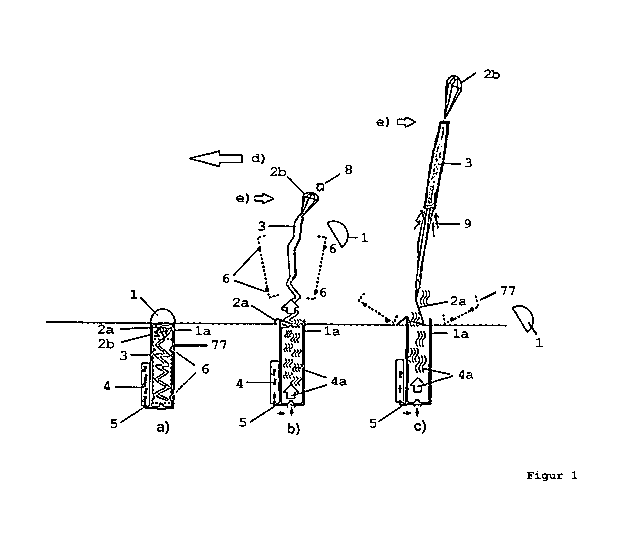Une partie des informations de ce site Web a été fournie par des sources externes. Le gouvernement du Canada n'assume aucune responsabilité concernant la précision, l'actualité ou la fiabilité des informations fournies par les sources externes. Les utilisateurs qui désirent employer cette information devraient consulter directement la source des informations. Le contenu fourni par les sources externes n'est pas assujetti aux exigences sur les langues officielles, la protection des renseignements personnels et l'accessibilité.
L'apparition de différences dans le texte et l'image des Revendications et de l'Abrégé dépend du moment auquel le document est publié. Les textes des Revendications et de l'Abrégé sont affichés :
| (12) Demande de brevet: | (11) CA 2979106 |
|---|---|
| (54) Titre français: | SYSTEME DE SAUVETAGE INTELLIGENT PAR PARACHUTES POUR AERONEFS AVEC ET SANS PILOTE |
| (54) Titre anglais: | INTELLIGENT PARACHUTE RESCUE SYSTEM FOR MANNED AND UNMANNED AERIAL VEHICLES |
| Statut: | Réputée abandonnée et au-delà du délai pour le rétablissement - en attente de la réponse à l’avis de communication rejetée |
| (51) Classification internationale des brevets (CIB): |
|
|---|---|
| (72) Inventeurs : |
|
| (73) Titulaires : |
|
| (71) Demandeurs : |
|
| (74) Agent: | MILLMAN IP INC. |
| (74) Co-agent: | AIRD & MCBURNEY LP |
| (45) Délivré: | |
| (86) Date de dépôt PCT: | 2016-03-10 |
| (87) Mise à la disponibilité du public: | 2016-09-15 |
| Licence disponible: | S.O. |
| Cédé au domaine public: | S.O. |
| (25) Langue des documents déposés: | Anglais |
| Traité de coopération en matière de brevets (PCT): | Oui |
|---|---|
| (86) Numéro de la demande PCT: | PCT/DE2016/100108 |
| (87) Numéro de publication internationale PCT: | WO 2016141928 |
| (85) Entrée nationale: | 2017-09-08 |
| (30) Données de priorité de la demande: | ||||||
|---|---|---|---|---|---|---|
|
La présente invention concerne un procédé et un dispositif pour un système de sauvetage intelligent par parachutes pour des aéronefs (14) avec et sans pilote. Selon ledit procédé, aucun agent propulseur pyrotechnique n'est utilisé, l'agent propulseur utilisé étant de l'air comprimé (4a) prélevé dans une bouteille d'air comprimé (4).
The invention relates to a method and a device for an intelligent parachute rescue system for manned and unmanned aerial vehicles (14), wherein no pyrotechnic propellants are used, but compressed air (4a) extracted from a pressure bottle (4).
Note : Les revendications sont présentées dans la langue officielle dans laquelle elles ont été soumises.
Note : Les descriptions sont présentées dans la langue officielle dans laquelle elles ont été soumises.

2024-08-01 : Dans le cadre de la transition vers les Brevets de nouvelle génération (BNG), la base de données sur les brevets canadiens (BDBC) contient désormais un Historique d'événement plus détaillé, qui reproduit le Journal des événements de notre nouvelle solution interne.
Veuillez noter que les événements débutant par « Inactive : » se réfèrent à des événements qui ne sont plus utilisés dans notre nouvelle solution interne.
Pour une meilleure compréhension de l'état de la demande ou brevet qui figure sur cette page, la rubrique Mise en garde , et les descriptions de Brevet , Historique d'événement , Taxes périodiques et Historique des paiements devraient être consultées.
| Description | Date |
|---|---|
| Inactive : Coagent ajouté | 2023-01-27 |
| Exigences relatives à la révocation de la nomination d'un agent - jugée conforme | 2022-11-23 |
| Exigences relatives à la nomination d'un agent - jugée conforme | 2022-11-23 |
| Demande non rétablie avant l'échéance | 2022-05-31 |
| Inactive : Morte - RE jamais faite | 2022-05-31 |
| Lettre envoyée | 2022-03-10 |
| Réputée abandonnée - omission de répondre à un avis sur les taxes pour le maintien en état | 2021-09-10 |
| Réputée abandonnée - omission de répondre à un avis relatif à une requête d'examen | 2021-05-31 |
| Lettre envoyée | 2021-03-10 |
| Lettre envoyée | 2021-03-10 |
| Représentant commun nommé | 2020-11-07 |
| Requête pour le changement d'adresse ou de mode de correspondance reçue | 2020-10-06 |
| Représentant commun nommé | 2019-10-30 |
| Représentant commun nommé | 2019-10-30 |
| Inactive : Page couverture publiée | 2017-09-28 |
| Inactive : Notice - Entrée phase nat. - Pas de RE | 2017-09-26 |
| Inactive : CIB en 1re position | 2017-09-22 |
| Inactive : CIB attribuée | 2017-09-22 |
| Inactive : CIB attribuée | 2017-09-19 |
| Lettre envoyée | 2017-09-19 |
| Inactive : CIB attribuée | 2017-09-19 |
| Demande reçue - PCT | 2017-09-19 |
| Exigences pour l'entrée dans la phase nationale - jugée conforme | 2017-09-08 |
| Demande publiée (accessible au public) | 2016-09-15 |
| Date d'abandonnement | Raison | Date de rétablissement |
|---|---|---|
| 2021-09-10 | ||
| 2021-05-31 |
Le dernier paiement a été reçu le 2020-01-21
Avis : Si le paiement en totalité n'a pas été reçu au plus tard à la date indiquée, une taxe supplémentaire peut être imposée, soit une des taxes suivantes :
Veuillez vous référer à la page web des taxes sur les brevets de l'OPIC pour voir tous les montants actuels des taxes.
| Type de taxes | Anniversaire | Échéance | Date payée |
|---|---|---|---|
| Enregistrement d'un document | 2017-09-08 | ||
| Taxe nationale de base - générale | 2017-09-08 | ||
| TM (demande, 2e anniv.) - générale | 02 | 2018-03-12 | 2018-02-13 |
| TM (demande, 3e anniv.) - générale | 03 | 2019-03-11 | 2019-02-11 |
| TM (demande, 4e anniv.) - générale | 04 | 2020-03-10 | 2020-01-21 |
Les titulaires actuels et antérieures au dossier sont affichés en ordre alphabétique.
| Titulaires actuels au dossier |
|---|
| KAPI ELECTRONICS GMBH |
| Titulaires antérieures au dossier |
|---|
| HOLGER KALINKA |